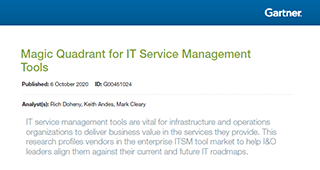Infrastructure and Operations, I&O, teams are broadly responsible for the administration and management of technology, information, and data. These teams manage a variety of elements including computers, servers, processes, networking, storage, data, software, security, and cloud-based services. Leaders of these teams are also responsible for hiring and training; creating policies; conducting testing; installing upgrades; and completing repairs.
While these tasks might sound technical, what I&O teams do is closely aligned with broader organizational goals, strategies, and operations. Put more simply, I&O teams are tasked with staying up-to-date on technological innovations and helping organizations meet their digital needs and goals. Further, they help to scale technological innovations effectively while enabling businesses to increase the quality of services while also reducing costs.
At a recent IT Infrastructure, Operations, and Cloud Strategy conference, Ross Winser, a senior analyst for Gartner, summed up this ever-changing role by saying, “The focus of I&O leaders is no longer to solely deliver engineering and operations, but instead deliver products and services that support and enable an organization’s business strategy.”
Understanding Trends in I&O
Gartner, a respected research and advisory company, made research-based predictions about changes and likely trends in I&O at their IT infrastructure conference as well as in their published planning guide. Their research outlines and discusses a number of anticipated shifts in the industry in a wide range of areas from the structure of teams to the way work gets done.
Perhaps the most basic but compelling theme from this research is the reality that, due to the ever-changing business demands and the ongoing shift towards digitalization and automation, I&O teams are required to develop and evolve constantly and rapidly. To help with that process, Gartner shared a few areas of expected shifts on which I&O leaders should focus. Here are some highlights from Gartner’s research as well as from other experts in the industry.
Changes in I&O Structures
Traditionally, I&O organizations have had a typical hierarchical structure, with a VP at the top of the organizational chart and various departments under the VP, often including a database, storage, security, and network department. While this has been the norm for organizational structure, experts suggest that a different model is ideal to meet current and future needs.
Many teams are shifting to become product, rather than project, focused. This shift, discussed in more detail below, impacts the way teams are structured. Shifting towards becoming product-focused leads to an increased need for team members from different departments to work together. The reorganization of I&O teams based on products is an effective way to meet this need and to ensure that work is completed in an efficient and timely manner. Further, it helps to confirm that relevant team members effectively work together, resulting in better outputs.
While this shift is needed and something for I&O leaders to prioritize, experts warn that this is a major, and likely disruptive, shift for many teams. As a result, it’s not a change to make all at once. Instead, it’s best done gradually and rolled out in phases.
The Importance of Having and Developing the Right Team Members
Another theme from Gartner’s research was the importance of having team members with the necessary skill sets and with the ability to develop and evolve as quickly as the industry does. A general takeaway was that having and developing employees with the right skill sets will ensure that all other pieces fall into place.
Senior analyst Winser effectively described the importance of human capital by saying, “In short, talent is the critical ingredient for a modern, high-performing technology organization, and great talent is in high demand. People that show versatility and adaptability are quickly becoming must-haves, particularly in hybrid environments.”
As quickly as the field has changed, some companies are finding that their I&O teams no longer have the right skill sets to meet organizational needs. For those, a transformation of people and finding individuals with the right skills and mindsets is an important first step. Regardless of whether you need to make major changes in your team, it’s always important to focus on talent management. Increasing the skills of your team, developing team-wide practices, and expanding procedures help to make departments more effective and competitive.
Encouraging Innovation
To stay competitive and at the front of the field, it’s important for companies to stay current with the latest technological advances while developing innovative ways to use this technology. Oftentimes, I&O is considered a way to put innovation into action, as opposed to being a source of innovation.
Experts assert that the more I&O leaders can be empowered to be creative and innovative, the more successful they will be. IT organizations generally fall into one of three categories – a solid utility, a trusted supplier, or a partner player. In those companies where IT is considered a partner player, teams are more likely to be focused on creative solutions and innovation that improve outcomes internally and externally. As a result, it’s beneficial to make I&O teams partner players and to empower them to be innovative leaders.
Other Noteworthy Trends that I&O Leaders Should Consider
Additional trends that emerged from Garner’s IT Infrastructure, Operations, and Cloud Strategies Conference provide guidance for I&O leaders for the next steps to take in 2020. A few of the most noteworthy include:
- Serverless Computing. While the name is a little misleading, as there are still servers, this refers to a shift towards having server providers that handle all underlying resources. This shift will leave I&O teams focused on Apps and SLAs instead of the traditional physical infrastructure.
- The Impact of AI. AI is increasingly being used by organizations and, more specifically, I&O leaders to help deal with increasing demands without having to proportionally increase their staff. Staying current on these trends will enable organizations to grow effectively, ensure that I&O needs are met, and not overwhelm their teams by demands.
- The End of Data Centers. Gartner predicts that by 2025, 80% of businesses will have done away with on-site data centers in favor of colocation and cloud hosting.
- An increase in Network Agility. I&O leaders are faced with ongoing demands for an increased pace of network operations due to increased internal and external factors. To meet these needs, it’s necessary to increase network agility and to utilize automation and analytics effectively.
- Products over Projects. As referenced above, there are ongoing shifts away from traditional project-focused thinking towards product-focused thinking. Doing so helps to better meet current IT needs and leads to outputs that have a bigger business-wide impact and that better meet customer needs.
We are currently living in the age of the customer – where consumers use apps, reviews, and a myriad of available tools to guide them in making decisions of all kinds. This shift is one of many things that has changed the landscape for Infrastructure and Operations organizations.
Reviewing Gartner’s predictions and guidelines can help I&O leaders prepare for and stay up-to-date with these and other ever-changing innovations and developments. Further, perhaps the biggest takeaway from all recent discussions on I&O is the need for leaders and team members to stay agile, innovative, and ready to respond to the changing demands of their field.






